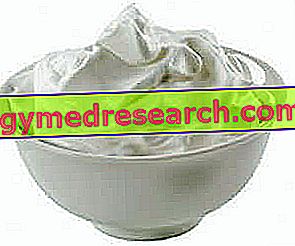Edited by Ivan Mercolini
Greetings to all lovers of beauty and well-being.
In this lesson I will talk about some over-the-counter supplements that have the function of stimulating the thyroid, supporting it in low-calorie diet regimes.
Index
- Three classic approaches to counteract the reduction in metabolism induced by low-calorie dietary regimes
- Thyroid physiology
- Coleus Forskohlii and Forskolina
- Commiphora mukul and Guggulsteroni
- Concluding notes on thyrostimulants
For those who do not know it yet, when making important cuts to their caloric intake - such as during the phases of definition and weight loss - there is a risk that your thyroid will respond by reducing the production of its hormones T3 and T4 which, as we shall see, are metabolic regulators together with catecholamines.

Ivan Mercolini>
- author of the article -
To overcome this reduction, the following classic "shelters" are used:
- Calorie cuts are made gradually . That is, instead of a sharp drop of -500 / -1000 Calories per day, it is preferable to make gradual, weekly, biweekly or monthly cuts of -100 / -250 calories / day, then checking the results twice a week or monthly, to then make a new cutting "step" until reaching its goals. The cut is preferentially dependent on the carbohydrate level, which gradually passes from the 5/6 g per kilo of an active normonutrito subject, up to 2 g per kilo (maximum). Users of AAS manage to fall - for a short period - even to 1g per kilo. Of course, part of this glucose reduction is obvious by increasing the protein content up to a maximum of 3.5 g per kilo (and beyond in hard-core agonists), in order to minimize catabolism. These principles, known to competitive body building since the 1970s, were taken up in this decade by various commercial diets that painted them their own color - with more or less numerous lashes of kitsch and errors / horrors known to any nutritionist biologist serious - and disseminated to the general public. I am not going to articulate beyond this point, as it is not the subject of this lesson; Suffice it to say that to avoid a drop in thyroid hormones and therefore of metabolism, those who start a weight loss diet should be careful to make gradual caloric cuts - in small steps of 100/250 Cal - weekly / bi-weekly / monthly depending on of the patient's medical history.
The decline in metabolism is in fact dangerous for those who want to cleanse their adipose tissue. It would result in a reduction in the rate of weight loss until it reaches a stall; not only, if the subject resumed a normocaloric diet, he would regain the lost pounds, and beyond, with extreme ease. The fall of the metabolism is therefore a very important enemy for those in weight loss.
- Physical activity is increased (or maintained) . It is well known that a moderately intense and constant program of physical activity supports the metabolism in low-calorie regimens. The increase in physical activity not only avoids the reduction of T3 / T4, but accelerates weight loss through greater energy expenditure. The drafting of the training program is subject dependent. In several cases an increase in volume and frequency is not necessary, especially in ectomorphs. In any case, however, it is appropriate to take advantage of this phase to include single-item exercises aimed at creating separation and quality. The personal trainer considers that if it is true that an increase in the volume of exercises involves a greater catabolism of the muscle, it is also true that it benefits the vascularization and the muscular compactness. Know how to dose the right exercises well to get the right effect.
Ransons aside, why does training support the metabolism? Meanwhile, this occurs only if it is reasonably intense. A walk, albeit healthy to capillarize and lymphatic circulation, has no significant effects on the metabolism. Conversely, a jogging session with repeated, but also simple fartlek, supports the production of T3 / T4. The greater the duration of training, its frequency, and above all its intensity, and the greater the incidence on the metabolism. And this occurs because intense physical activity involves significant changes in the organism's homeostasis. During an intense exercise, to cope with the greater demolition of glycogen and triglycerides, for the alanine-glucose cycle and for the hepatic conversion of lactate (therefore for energy metabolism in general), during the hours - and I will say days - rest to recover and overcompensate (= restoration of calcium ions, repair of muscle microtraumas, glycogen reconstruction, hypertrophy and hyperplasia of mitochondria, increase in the number and size of contractile units, etc., etc.).
- Metabolism stimulants are used . The best known are guarana, caffeine, green tea ... etc., and among those banned today is ephedra. Other banned pharmaceutical stimulants are amphetamines and clenbuterol. They act on beta receptors directly - mimicking the action of catecholamines - and indirectly stimulating the adrenal gland to produce adrenaline and noradrenaline. They have an inotropic and chronotropic positive effect on the myocardium, and significantly increase the metabolism in synergistic action at TSH (we will then see this important "collaboration"). Their action on the nervous system leads to better neuromuscular coordination, thus maximizing congestion. Tone also benefits significantly, since sympathomimetics increase the time spent on muscle plate discharges in post-work-out. Although it is not the subject of this lesson, it should be noted briefly that these supplements have different side effects (dose dependent) and different contraindications. Therefore, it is advisable for the inexperienced user to consult a health professional before starting a specific supplement. And again: even in the case of use, this will not be extended beyond two months, which will be followed by a period of abstention of at least another month. I point out that in order to increase lipolysis, vascularization and metabolism, one can also act in a specular manner using an alpha-blocker such as yohimbine. Unfortunately, however, to date (Summer 2012) this product cannot be sold over the counter, after having been for several years.
The three points mentioned above show the most common and widespread methods to support the metabolism in the phases of definition or weight loss. Subject of this discussion will be two other useful substances for this purpose, although they are less mentioned and used by aesthetes and fitness lovers: guggulsterones and forskolin . I immediately give you the first good news: they are products that can be sold without a prescription. And I also give you the second good news immediately: they actually WORK.
To understand their function you need a moment of patience first: you need to know the physiology of the thyroid, at least in its most important points. Follow me in my long-winded and boring saying in the next chapter ...



